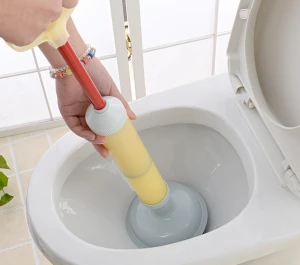Mastering Plunger and Drain Cleaners: Professional Techniques
Mastering Plunger and Drain Cleaners: Professional Techniques
Blog Article
What're your concepts about Tips on How to Effectively Use a Plunger?

Introduction
Proper maintenance of family drains is essential for avoiding blockages and guaranteeing smooth water circulation. Among the trick devices in every homeowner's toolkit is the bettor, together with various drainpipe cleansers created to take on stubborn clogs efficiently. This short article checks out how to make use of bettors and drain cleaners effectively to keep your drains pipes streaming easily.
Area 1: Recognizing Bettors
Kinds of Plungers
There are a number of sorts of plungers offered, each designed for different types of drains and blocks. The most common types include mug bettors, flange plungers, and accordion plungers.
How Plungers Work
Bettors work with the concept of producing pressure and suction to dislodge clogs. When properly used over a drain, they produce a vacuum cleaner that can pull out particles or break up blockages.
Choosing the Right Bettor
Choosing the appropriate bettor relies on the sort of drainpipe and the nature of the obstruction. Cup bettors are excellent for sinks and bathtubs, while flange plungers are much better suited for commodes because of their design.
Usual Errors with Plungers
Preventing these mistakes makes certain efficient plunging: improper seal around the drain, not enough pressure, and unclear surrounding debris.
Section 2: Making Use Of Plungers Efficiently
Prep work
Prior to diving, ensure the plunger covers the drain totally and creates a tight seal. Clear any type of visible debris around the drain opening.
Strategy
Begin with mild diving activities to construct suction. Rise stress progressively, making use of a constant rhythm. Repeat as necessary till the drainpipe removes.
Fixing Tips
If plunging does not function, try changing the seal, using petroleum jelly for a far better seal, or making use of a various kind of bettor.
Area 3: Comprehending Drainpipe Cleaners
Sorts Of Drain Cleaners
Drain cleansers can be chemical or enzymatic. Chemical cleansers utilize strong chemicals to liquify clogs, while chemical cleaners utilize natural enzymes to break down raw material.
How Drainpipe Cleaners Job
Chemical cleaners respond with clogs to liquify them, while chemical cleansers break down organic materials like hair and oil without harming pipelines.
Safety and security Considerations
Always wear gloves and eye defense when utilizing chemical drain cleaners. Guarantee appropriate air flow and adhere to manufacturer instructions meticulously.
Eco-Friendly Alternatives
Consider utilizing vinegar and baking soda or enzyme-based cleansers for eco-friendly options that are more secure for pipes and the setting.
Area 4: Making Use Of Drain Cleansers Efficiently
Application Methods
Pour chemical cleansers directly right into the drain opening. Permit them to benefit the advised time before flushing with hot water. Chemical cleansers ought to rest overnight.
Preventative measures
Avoid blending various types of cleaners, as this can produce hazardous fumes. Never utilize chemical cleansers along with a plunger, as spilling can occur.
Taking Care Of Stubborn Obstructions
For consistent clogs, take into consideration making use of a pipes snake or calling an expert plumbing technician to avoid damages to pipelines.
Verdict
To conclude, comprehending how to use bettors and drain cleaners successfully is essential for preserving healthy and balanced pipes systems. By choosing the right devices and techniques, property owners can tackle minor blockages and stop significant pipes concerns down the line.
How to Use a Plunger to Unclog a Drain
The humble plunger is a simple yet effective tool for breaking clogs in sinks, tubs and toilets. This handy tool is easy to use. You can make the most of its power if you understand how it works. Ready to dive in? Here’s what you need to know.
Safety First!
Never use a plunger with drain chemicals. Water will splash as you work, and the chemicals can spatter, burning skin and eyes. It’s a good idea to use rubber gloves and wear safety goggles when you work on a clog.
Choose the Right Tool for the Job
Plungers come in two different styles. Sinks, bathtubs and showers require a cup plunger. Like its name suggests, the rubber end is shaped like a cup. Use a flange plunger on toilets. These plungers have a rubber funnel extending from the cup. A plunger needs to be big enough to cover the drain.
Ready, Set, Plunge!
Coat the rim: Coat the plunger rim with petroleum jelly. This helps make a better seal. Block outlets: Hold a wet rag over nearby outlets such as the overflow vent or the drain in a second sink. Release air: Insert the plunger at an angle into the water. Water will displace air in the cup. A water-filled cup is more forceful than one filled with air. Keep the plunger upright: Hold the plunger perpendicular to the drain. Use fast, forceful strokes, but make the first stroke gentle. The first stroke can create a splash if the cup still contains air. Thrust the plunger 15 to 20 times. Snap off the plunger: The final stroke should be a strong upward motion that ends when the plunger snaps off the drain. Repeat the process: you may need to repeat this sequence several times. When the water drains away, your work is done. High-five! https://plumbernw.com/blog/how-to-use-a-plunger-to-unclog-a-drain/

As a person who reads on How To Use Your Toilet Plunger Correctly in 5 Easy Steps, I imagined sharing that post was essential. Sharing is nice. Helping people is fun. Many thanks for your time. Please come visit our website back soon.
Request Service Report this page